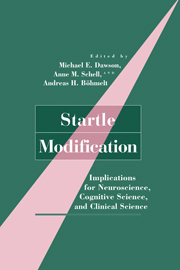Book contents
- Frontmatter
- Contents
- Contributors
- Preface
- Prologue: A Historical Note on the “Discovery” of Startle Modification
- 1 Startle Modification: Introduction and Overview
- PART I BASIC PARADIGMS, METHODS, AND PHENOMENA
- PART II PHYSIOLOGICAL MEDIATION OF STARTLE MODIFICATION
- PART III PSYCHOLOGICAL MEDIATION OF STARTLE MODIFICATION
- PART IV INDIVIDUAL DIFFERENCES AND STARTLE MODIFICATION
- PART V RELATIONSHIPS WITH OTHER PARADIGMS AND MEASURES
- References
- Author Index
- Subject Index
1 - Startle Modification: Introduction and Overview
Published online by Cambridge University Press: 26 March 2010
- Frontmatter
- Contents
- Contributors
- Preface
- Prologue: A Historical Note on the “Discovery” of Startle Modification
- 1 Startle Modification: Introduction and Overview
- PART I BASIC PARADIGMS, METHODS, AND PHENOMENA
- PART II PHYSIOLOGICAL MEDIATION OF STARTLE MODIFICATION
- PART III PSYCHOLOGICAL MEDIATION OF STARTLE MODIFICATION
- PART IV INDIVIDUAL DIFFERENCES AND STARTLE MODIFICATION
- PART V RELATIONSHIPS WITH OTHER PARADIGMS AND MEASURES
- References
- Author Index
- Subject Index
Summary
ABSTRACT
Startle modification refers to a set of reliable and ubiquitous phenomena. Specifically, the startle modification phenomena include the inhibition and facilitation of the startle reflex by nonstartling stimuli that accompany or precede the startle-eliciting stimulus. This chapter introduces these phenomena through historical examples drawn from both the human and nonhuman animal literature. Both the inhibition and the facilitation of the startle reflex are illustrated. The standard terms used throughout this book – “startle stimulus,” “lead stimulus,” and “lead interval” – are defined by reference to these prototypical examples. Potential implications of startle modification phenomena are identified for cognitive science, neuroscience, and clinical science, with special emphasis on integrative implications. Finally, the book is outlined with reference to each of the subsequent chapters.
Introduction and Brief History
Reflexes are often considered simple, fixed, and invariant reactions to stimuli. However, it has been known for a number of years that reflexes are not fixed; rather, they are highly modifiable by a variety of events that occur concurrent with or immediately before the elicitation of the reflex. The amplitude of the patellar tendon “knee-jerk” reflex, for example, was shown over 100 years ago to vary systematically depending upon the time at which a voluntary motor response preceded the elicitation of the reflex (Bowditch & Warren, 1890). The amplitude of the human patellar reflex was facilitated if participants voluntarily clinched their hands in response to a bell simultaneously with the blow upon the tendon, but the reflex was inhibited, sometimes disappearing entirely, if the hand clinch occurred only a few hundred milliseconds before the patellar stimulation.
- Type
- Chapter
- Information
- Startle ModificationImplications for Neuroscience, Cognitive Science, and Clinical Science, pp. 6 - 18Publisher: Cambridge University PressPrint publication year: 1999
- 8
- Cited by



